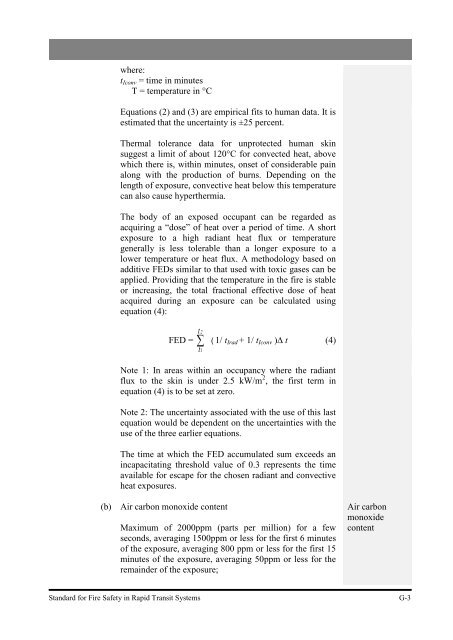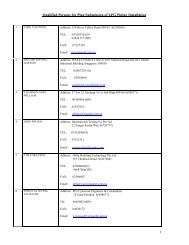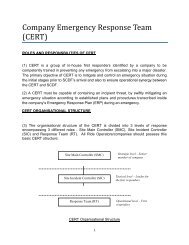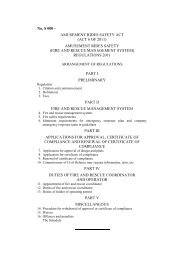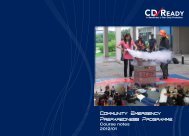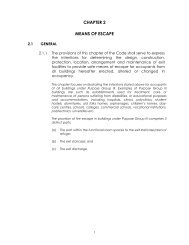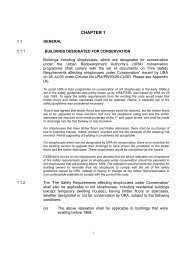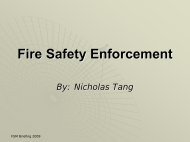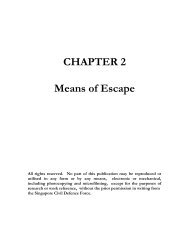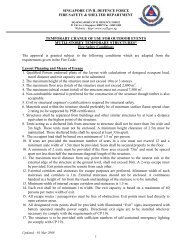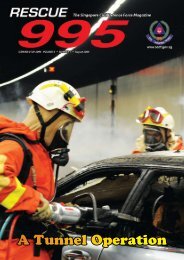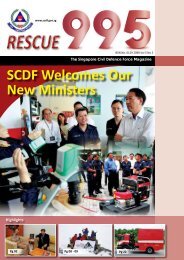Standard for Fire Safety in Rapid Transit Systems - Singapore Civil ...
Standard for Fire Safety in Rapid Transit Systems - Singapore Civil ...
Standard for Fire Safety in Rapid Transit Systems - Singapore Civil ...
Create successful ePaper yourself
Turn your PDF publications into a flip-book with our unique Google optimized e-Paper software.
where:<br />
tIconv = time <strong>in</strong> m<strong>in</strong>utes<br />
T = temperature <strong>in</strong> °C<br />
Equations (2) and (3) are empirical fits to human data. It is<br />
estimated that the uncerta<strong>in</strong>ty is ±25 percent.<br />
Thermal tolerance data <strong>for</strong> unprotected human sk<strong>in</strong><br />
suggest a limit of about 120°C <strong>for</strong> convected heat, above<br />
which there is, with<strong>in</strong> m<strong>in</strong>utes, onset of considerable pa<strong>in</strong><br />
along with the production of burns. Depend<strong>in</strong>g on the<br />
length of exposure, convective heat below this temperature<br />
can also cause hyperthermia.<br />
The body of an exposed occupant can be regarded as<br />
acquir<strong>in</strong>g a “dose” of heat over a period of time. A short<br />
exposure to a high radiant heat flux or temperature<br />
generally is less tolerable than a longer exposure to a<br />
lower temperature or heat flux. A methodology based on<br />
additive FEDs similar to that used with toxic gases can be<br />
applied. Provid<strong>in</strong>g that the temperature <strong>in</strong> the fire is stable<br />
or <strong>in</strong>creas<strong>in</strong>g, the total fractional effective dose of heat<br />
acquired dur<strong>in</strong>g an exposure can be calculated us<strong>in</strong>g<br />
equation (4):<br />
FED = 2 t<br />
t<br />
1<br />
( 1/ tIrad + 1/ tIconv ) t (4)<br />
Note 1: In areas with<strong>in</strong> an occupancy where the radiant<br />
flux to the sk<strong>in</strong> is under 2.5 kW/m 2 , the first term <strong>in</strong><br />
equation (4) is to be set at zero.<br />
Note 2: The uncerta<strong>in</strong>ty associated with the use of this last<br />
equation would be dependent on the uncerta<strong>in</strong>ties with the<br />
use of the three earlier equations.<br />
The time at which the FED accumulated sum exceeds an<br />
<strong>in</strong>capacitat<strong>in</strong>g threshold value of 0.3 represents the time<br />
available <strong>for</strong> escape <strong>for</strong> the chosen radiant and convective<br />
heat exposures.<br />
(b) Air carbon monoxide content<br />
Maximum of 2000ppm (parts per million) <strong>for</strong> a few<br />
seconds, averag<strong>in</strong>g 1500ppm or less <strong>for</strong> the first 6 m<strong>in</strong>utes<br />
of the exposure, averag<strong>in</strong>g 800 ppm or less <strong>for</strong> the first 15<br />
m<strong>in</strong>utes of the exposure, averag<strong>in</strong>g 50ppm or less <strong>for</strong> the<br />
rema<strong>in</strong>der of the exposure;<br />
Air carbon<br />
monoxide<br />
content<br />
<strong>Standard</strong> <strong>for</strong> <strong>Fire</strong> <strong>Safety</strong> <strong>in</strong> <strong>Rapid</strong> <strong>Transit</strong> <strong>Systems</strong> G-3


